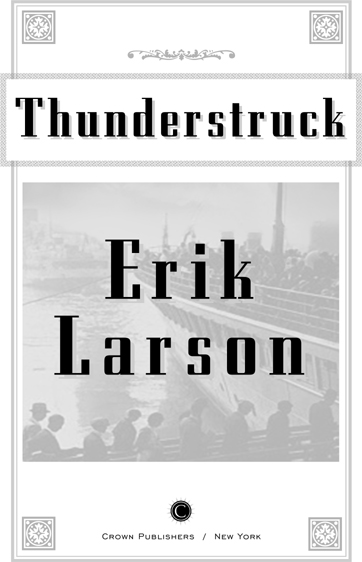For my wife and daughters,
and in memory of my mother,
who first told me about Crippen
A NOTE TO READERS

THERE IS MURDER IN THIS BOOK, the second most famous in England, but what I intend here is more than a saga of violence. P. D. James in The Murder Room has one of her characters observe, “Murder, the unique crime, is a paradigm of its age.” By chronicling the converging stories of a killer and an inventor, I hope to present a fresh portrait of the period 1900 to 1910, when Edward VII ruled the British Empire with a slightly pudgy cigar-stained hand, assuring his subjects that duty was important but so too was fun. “It doesn’t matter what you do,” he said, “so long as you don’t frighten the horses.”
The murder fascinated Raymond Chandler and so captivated Alfred Hitchcock that he worked elements into some of his movies, most notably Rear Window. Followed by millions of newspaper readers around the world, the great chase that ensued helped advance the evolution of a technology we today take utterly for granted. “It was hot news indeed,” wrote playwright and essayist J. B. Priestley, himself a scion of the Edwardian age, “something was happening for the first time in world history.” There was a poignancy as well, for the story unfolded during what many, looking back, would consider the last sunny time before World War I, or as Priestley put it, “before the real wars came, before the fatal telegrams arrived at every great house.”
This is a work of nonfiction. Anything appearing between quotation marks comes from a letter, memoir, or other written document. I relied heavily on investigative reports from Scotland Yard, many of which as best I can tell have not previously been published. I ask readers to forgive my passion for digression. If, for example, you learn more than you need to know about a certain piece of flesh, I apologize in advance, though I confess I make that apology only halfheartedly.
Erik Larson
Seattle
2006
A safe but sometimes chilly way of recalling the past is to force open a crammed drawer. If you are searching for anything in particular you don’t find it, but something falls out at the back that is often more interesting.
J. M. Barrie
“Dedication”
Peter Pan
1904
THE MYSTERIOUS PASSENGERS

ON WEDNESDAY, JULY 20, 1910, as a light fog drifted along the River Scheldt, Capt. Henry George Kendall prepared his ship, the SS Montrose, for what should have been the most routine of voyages, from Antwerp direct to Quebec City, Canada. At eight-thirty in the morning the passengers began streaming aboard. He called them “souls.” The ship’s manifest showed 266 in all.
Captain Kendall had a strong jaw and a wide mouth that bent easily into a smile, a trait that made him popular among all passengers but especially women. He told good stories and laughed easily. He did not drink. By standards prevailing at the time, he was young to have command of his own ship, only thirty-five years old, but he was by no means untested. Already he had lived a life as eventful as any imagined by Joseph Conrad, whose novels always were popular among passengers once the Montrose entered the vast indigo plain of the Atlantic, though thrillers and detective tales and the latest books warning of a German invasion were in demand as well.
As an apprentice seaman, Kendall had served aboard a brutal vessel with a charming name, Iolanthe, where he witnessed the murder of a shipmate by an unstable crew member, who then began stalking Kendall to silence him. Kendall fled the ship and tried his hand at mining gold in Australia, a pursuit that left him penniless and hungry. He stowed away on another ship, but the captain caught him and marooned him on Thursday Island, in the Torres Strait off Queensland. After a brief stint harvesting pearls, Kendall joined a small Norwegian barkentine—a three-masted sailing ship—carrying seagull excrement bound for farms in Europe, but storms tore away portions of its masts and turned the voyage into an epic of starvation and stench that lasted 195 days. His love of ships and the sea endured, however. He joined the crew of the Lake Champlain, a small steam-powered cargo ship owned by the Beaver Line of Canada but subsequently acquired by the Canadian Pacific Railway. He was its second officer in May 1901, when it became the first merchant vessel to be equipped with wireless. He caught the attention of his superiors and soon found himself first officer on the railway’s flagship liner, the Empress of Ireland. In 1907 he gained command of the Montrose.
It was not the most glamorous of ships, especially when compared to the Empress, which was new and nearly three times as large and infinitely more luxurious. The Montrose was launched in 1897 and in succeeding years ferried troops to the Boer War and cattle to England. It had one funnel, painted Canadian Pacific’s trademark colors—buff with a black top—and flew the line’s red-and-white-checkered “house” flag. It carried only two classes, second and third, the latter known more commonly as “steerage,” a term that originally denoted the belowdecks portion of a ship devoted to steering. A Canadian Pacific timetable from the era described the second-class quarters. “The Cabin accommodation on the MONTROSE is situated amidship, where least motion is felt. The staterooms are large, light and airy. There is a comfortable ladies’ room and a smoking room, also a spacious promenade deck. An excellent table is provided. Surgeons and stewardesses are carried on all steamers.” The line’s motto was, “A little better than the best.”
The manifest for the upcoming voyage listed only 20 passengers in second class but 246 in third, nearly all immigrants. In addition the Montrose carried a crew of 107, among them a wireless operator, Llewellyn Jones. Canadian Pacific had been aggressive about installing wireless on its transoceanic




